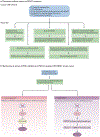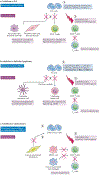PI3K inhibitors are finally coming of age
- PMID: 34127844
- PMCID: PMC9297732
- DOI: 10.1038/s41573-021-00209-1
PI3K inhibitors are finally coming of age
Erratum in
-
Author Correction: PI3K inhibitors are finally coming of age.Nat Rev Drug Discov. 2021 Oct;20(10):798. doi: 10.1038/s41573-021-00300-7. Nat Rev Drug Discov. 2021. PMID: 34471263 No abstract available.
Abstract
Overactive phosphoinositide 3-kinase (PI3K) in cancer and immune dysregulation has spurred extensive efforts to develop therapeutic PI3K inhibitors. Although progress has been hampered by issues such as poor drug tolerance and drug resistance, several PI3K inhibitors have now received regulatory approval - the PI3Kα isoform-selective inhibitor alpelisib for the treatment of breast cancer and inhibitors mainly aimed at the leukocyte-enriched PI3Kδ in B cell malignancies. In addition to targeting cancer cell-intrinsic PI3K activity, emerging evidence highlights the potential of PI3K inhibitors in cancer immunotherapy. This Review summarizes key discoveries that aid the clinical translation of PI3Kα and PI3Kδ inhibitors, highlighting lessons learnt and future opportunities.
© 2021. Springer Nature Limited.
Conflict of interest statement
Figures






Similar articles
-
Drugging the Phosphoinositide 3-Kinase (PI3K) and Phosphatidylinositol 4-Kinase (PI4K) Family of Enzymes for Treatment of Cancer, Immune Disorders, and Viral/Parasitic Infections.Adv Exp Med Biol. 2020;1274:203-222. doi: 10.1007/978-3-030-50621-6_9. Adv Exp Med Biol. 2020. PMID: 32894512 Review.
-
Efficacy of PI3K inhibitors in advanced breast cancer.Ann Oncol. 2019 Dec 1;30(Suppl_10):x12-x20. doi: 10.1093/annonc/mdz381. Ann Oncol. 2019. PMID: 31859349 Free PMC article. Review.
-
Phosphatidylinositol 3-kinase (PI3K) inhibitors: a recent update on inhibitor design and clinical trials (2016-2020).Expert Opin Ther Pat. 2021 Oct;31(10):877-892. doi: 10.1080/13543776.2021.1924150. Epub 2021 May 16. Expert Opin Ther Pat. 2021. PMID: 33970742 Review.
-
Targeting PI3K in cancer treatment: A comprehensive review with insights from clinical outcomes.Eur J Pharmacol. 2025 Jun 5;996:177432. doi: 10.1016/j.ejphar.2025.177432. Epub 2025 Feb 26. Eur J Pharmacol. 2025. PMID: 40020984 Review.
-
PI3K Isoform-Selective Inhibitors in Cancer.Adv Exp Med Biol. 2020;1255:165-173. doi: 10.1007/978-981-15-4494-1_14. Adv Exp Med Biol. 2020. PMID: 32949399 Review.
Cited by
-
First-in-human phase Ia study of the PI3Kα inhibitor CYH33 in patients with solid tumors.Nat Commun. 2022 Nov 16;13(1):7012. doi: 10.1038/s41467-022-34782-9. Nat Commun. 2022. PMID: 36385120 Free PMC article. Clinical Trial.
-
Zandelisib (ME-401) in Japanese patients with relapsed or refractory indolent non-Hodgkin's lymphoma: an open-label, multicenter, dose-escalation phase 1 study.Int J Hematol. 2022 Dec;116(6):911-921. doi: 10.1007/s12185-022-03450-5. Epub 2022 Sep 15. Int J Hematol. 2022. PMID: 36107394 Free PMC article. Clinical Trial.
-
Simultaneous inhibition of PI3K and PAK in preclinical models of neurofibromatosis type 2-related schwannomatosis.Oncogene. 2024 Mar;43(13):921-930. doi: 10.1038/s41388-024-02958-w. Epub 2024 Feb 9. Oncogene. 2024. PMID: 38336988 Free PMC article.
-
The Study of PIK3CA Hotspot Mutations and Co-Occurring with EGFR, KRAS, and TP53 Mutations in Non-Small Cell Lung Cancer.Onco Targets Ther. 2024 Sep 11;17:755-763. doi: 10.2147/OTT.S468352. eCollection 2024. Onco Targets Ther. 2024. PMID: 39282132 Free PMC article.
-
Functional impact and molecular binding modes of drugs that target the PI3K isoform p110δ.Commun Biol. 2023 Jun 5;6(1):603. doi: 10.1038/s42003-023-04921-z. Commun Biol. 2023. PMID: 37277510 Free PMC article.
References
Publication types
MeSH terms
Substances
Grants and funding
LinkOut - more resources
Full Text Sources
Other Literature Sources

